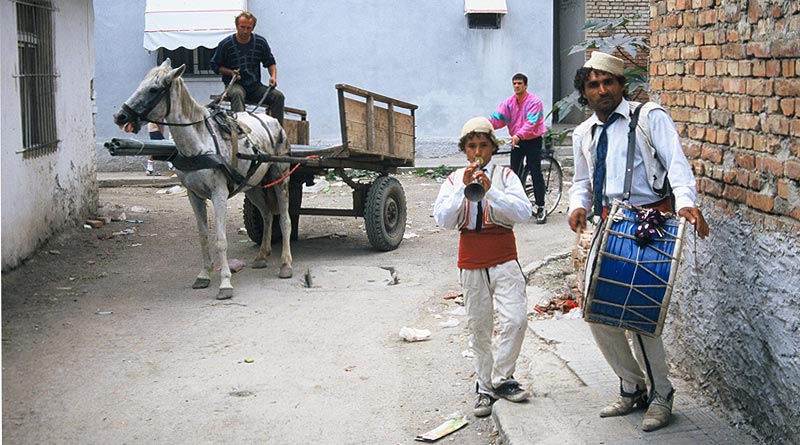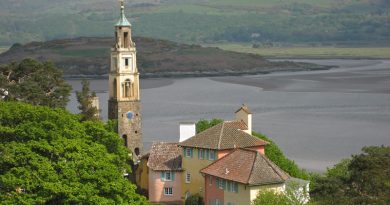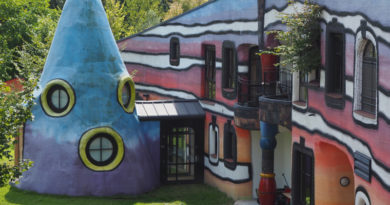Last bus to Shqipëria
It’s true, in a way, what they say about Albania — that it’s a mad, dangerous place — though not for the reasons travel books usually harp on about.
The danger lurking around street corners in Albania is not a desperate, moustachioed bandit, but something rather more pedestrian: Someone has nicked all the manhole covers. Every last one of them.
And in the towns where thieves have been especially bold and made off with the lampposts as well, it takes a brave — or reckless — traveller to venture out after dark.
The gaping manholes and a few discomforts aside, however, Albania is a land of unexpected pleasures. And in an ever more homogeneous McWorld, Albania remains uniquely … well, Albanian.
That Bible of the independent traveller, Lonely Planet, makes Albania more irresistible still by complementing its list of highlights (the usual museums and Roman ruins) with a summary of the country’s “lowlights”:
“Broken-down and abandoned factories that litter the countryside. Abysmal roads and chaotic driving conditions. The one million Kalashnikov rifles that have been taken by one in four residents of Albania. Former state-run hotels. The Steel of the Party factory in Elbasan…”
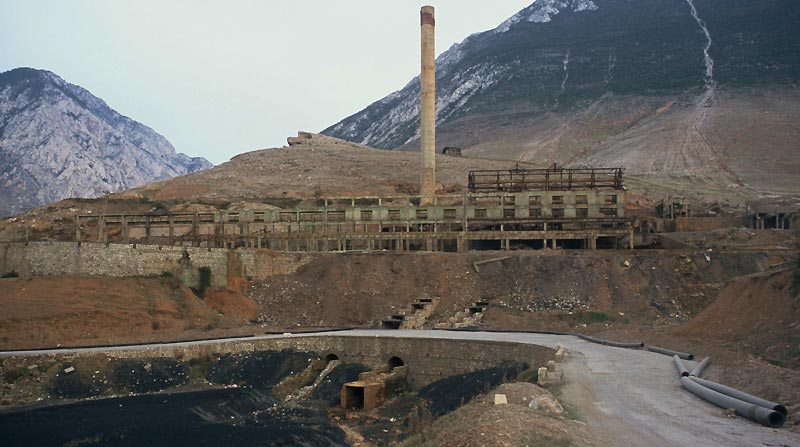
Needless to say, that clinched it. I had to take a holiday in Albania, or as the locals more evocatively call it, Shqipëria – The Land of the Eagle.
· · · · ·
The border town of Kukës made world headlines in 1999 when it was the first stop for thousands of refugees fleeing Kosovo. Usually a town of 25,000 people, for a few months it was home to as many as 350,000.
“People were everywhere,” said local writer Petrit Palushi.
“Every house was full, and they were sleeping three to a table in the billiard halls.”
But when I stumbled off the bus, apart from the odd aid convoy rumbling through, Kukës was slumbering again. Life might be slow in Kukës, but the location — sandwiched between the 70 square kilometre Light of the Party hydroelectric reservoir and the 2000-metre-high Mt Gjalica — is spectacular.
One of the novelties of travelling in Kukës, or almost anywhere in Albania, is the lack of street names or numbers. Nor do the Albanians have much use for the signs that usually identify banks, shops, hotels, railway stations and the like. Finding things can be interesting.
Fortunately, I had a guidebook to direct me to Kukës’ cheapest hotel:
“An unmarked three-storey building on the nameless main street in the centre of town, opposite a place with the large yellow sign, Fruta Perime.”
Sure enough, a few hundred metres down the nameless main street from an unnamed square that serves as the bus station, and opposite a yellow sign advertising fruit and vegetables, stood an unmarked and fairly nondescript building, the Hotel Gjalica.
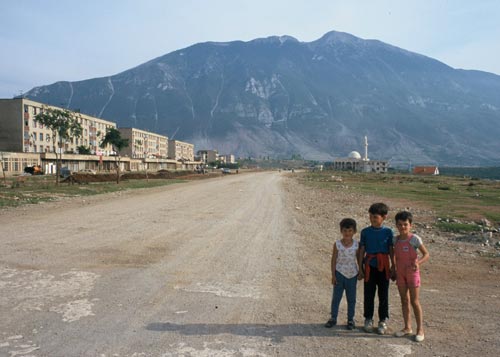
The receptionist was terse. “$US35 for one night,” she said.
“Er… will you take ten?” I asked timidly.
“Po,” she said, shaking her head, which means yes in Albania. I should have gone for $5.
By the next morning, I was moved to complain about the lack from the hotel’s taps to complain.
“Ujë,” I whined at the receptionist, “water”.
The receptionist said something that may have translated as “bloody tourist”, and flicked a switch on the wall behind her. A pump spluttered into life and water gurgled noisily through the pipes.
“Ujë,” she said.
· · · · ·
Another thing about Albania is the intense curiosity and hospitality of its people. They just kept giving me stuff. In my first two days in Kukës, I kept a list of the things they gave me:
Three bananas.
Four doughnuts.
One pack of NATO-brand chewing gum (with a free sticker showing a Serb atrocity in Kosovo, number 14 of a set).
Five cups of coffee, as thick and dark as crude oil.
A bicycle for an afternoon.
A book, signed by the author and entitled Kukësi në 79 ditë, which, alas, I cannot read.
There was also a large amount of the local cognac on my second evening, which, oddly enough, is when I lost count.
· · · · ·
Albania’s capital, Tirana, is a scenic but terrifying 200km or seven hours away over the mountains. Like most bus journeys in Albania, it begins ominously with the driver handing out plastic sickie bags.
The drivers have also devised a strategy for helping passengers forget their nausea. This typically involves taking a hairpin bend above a precipice on an unsealed road half blocked by a rusting truck chassis, just as a dozen overloaded cars are driving excitedly to a village wedding from the other direction.
Better to forget the road too, and concentrate on the scenery – mountains like rows of sharks’ teeth; broad valleys and braided, shingle-bedded rivers; olive groves clinging to hills of bare orange earth; and all of it sprinkled liberally with the wreckage of too many five-year industrial plans.
Little wonder that some aid workers, en route to Kosovo, assume the Yugoslav army must have overrun Albania as well.
Tirana itself is a surprisingly pleasant and normal place. Several times a day, passers-by stopped me to point out that the 11-storey Tirana International Hotel is the tallest building in the country.
It also has its own electricity substation occupying a corner of Skënderbeg Square, to spare its visiting dignitaries and missionaries the discomforts of everyday Albanian life.
In Tirana, everyone who owns an upturned cardboard box is a stallholder. Marlboros, bananas, sanitary pads and the other trappings of Western prosperity are popular, but the stalls selling photocopied US green card lottery forms pull the biggest crowds. The more professional stalls throw in envelopes and postage and fill in the form for you, selling hope at 100 lekë ($0.80) a time.
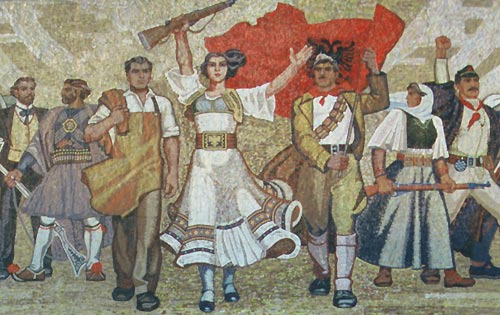
But the city’s real business takes place on a dusty square in front of the central post office, where a hundred or so men mill about in Italian suits, armed with calculators and inch-thick wads of banknotes.
There are no queues, no fees, and they are always open. Banks everywhere could learn from Tirana’s black market.
One morning they quoted me a mere 128 lekë to the US dollar, four lekë less than the day before. A money changer was explaining how the dollar had fallen overnight when his cell phone bleeped urgently. He listened for a moment and called out something that sparked a flurry of calculating among his colleagues.
“The dollar has slipped another half a point in New York,” he explained.
· · · · ·
Elbasan, another frightening bus ride away, boasts as its main distinguishing feature a mammoth Chinese-built steel mill.
Twenty-year-old Albert Bojaxhui works in the city’s only hotel. Inexplicably, his English is flawless and tinged with a British Midlands accent. He is also a fully paid up member of the Manchester United fan club.
Albert, like every other young man in Albania, wants to get out, but the only country that will grant him a visa is Macedonia.
He has savings stashed away somewhere, but won’t start up a business, “in case people go crazy again like in 1997 and destroy everything.”

The events of 1997 also offer a clue as to disappearance of the manhole covers. In 1991 Albania lurched to a market economy from a society that had been closed to the outside world for 40 years and in which even owning a private car was illegal.
The transformation was enormous, and it’s hardly surprising that things didn’t go smoothly.
Many Albanians, naïve about the ways of capitalism, sank their life savings into pyramid schemes. When those collapsed in 1996-97, the government copped the blame. The country plunged into chaos and near civil war, soldiers and police deserted, a million guns were looted from state armouries and much of the country’s infrastructure was destroyed.
“No one here is against democracy and the changes since 1991,” said Albert, “but the changes came too fast. We could not adapt.”
And in the meantime, until he gets a visa to anywhere, Albert waits.
Albert is not alone. Squatting on their heels in a peculiarly Albanian way, along every roadside and at every street corner, young Albanian men endlessly chew sunflower seeds and wait for things to get better.
· · · · ·
Perched on a hilltop above the port city of Durrës, with its Roman amphitheatre and pretty seaside promenade, is the former palace of King Zog I.
Today, ringed by sandbags and bristling with antennae, it is an Italian military base. Ostensibly the Italians are in town to protect aid shipments, but everyone knows the real reason: To stop young men seeking their fortunes abroad by highjacking the first passing ship to Italy, just 100km across the Adriatic Sea.
In the cafés the old men mutter that nowadays the country is a puppet of the Italians. Or the Greeks, the Americans, the Serbs or the IMF, depending on who you talk to.
But there was a time, as the old men will tell you, when the ancient Illyrians – ancestors of today’s Albanians – ruled half the Balkans. When the Italians were still running about naked in the woods.

Two weeks of extraordinary hospitality, scenery and squalor later, and with a head full of new friends and half fogged by konjak, my holiday was over.
I hitched a ride out to the Greek border with Gunther, a German aid worker driving one of the Balkans’ ubiquitous white UN Landrovers.
At an insanely potholed blind corner, two young men in leather jackets tore past helmetless on a motorbike.
“Yeeeeha!” they hollered as they tore past. Gunther stuck his head out the window and bellowed back. Laughing, he shouted to me above the racket: “They are policemen. Albania is a crazy country.”
He meant it, of course, in the best possible way. And he was right.
First published in The New Zealand Listener, February 2002.
The Land of the Eagle
Albania is a country of just over three million people across the Adriatic Sea from Italy, bordering Serbia and Montenegro, Macedonia and Greece.
It packs a lot of rugged scenery into a small area – at 28,000 square kilometres it’s just a tenth the size of New Zealand.
Until 1990 it was all but closed to outsiders, aligned with China and as paranoid of the Soviet Bloc as it was of the West. The countryside is still littered with millions of mushroom-shaped concrete bunkers, built in the 1960s amid fear of an invasion from its neighbours.
Albania was also one of the last countries in Eastern Europe to dismantle its one-party system after the wave of revolutions that swept Europe in 1989.
Since then it hasn’t exactly had a smooth path to democracy. In 1996-97 the collapse of a popular pyramid investment scheme saw most Albanians lose their life savings and the county plunge into chaos.
Some progress has been made, however, in rebuilding the country. It is, for example, no longer Europe’s poorest country (that dubious honour now belongs to Moldova) and is drawing an increasing number of tourists.
Until the 1990s it was the world’s only officially atheist state; now churches and mosques are springing up in a country which is part Catholic, part Eastern Orthodox and part Muslim.
This story was written after an extraordinary trip through Albania in 1999, only months after the war in next-door Kosovo and a few weeks after Nato forces and refugees had packed up and gone home.

